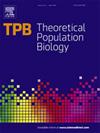Conditional gene genealogies given the population pedigree for a diploid Moran model with selfing
IF 1.3
4区 生物学
Q4 ECOLOGY
引用次数: 0
Abstract
We introduce a stochastic model of a population with overlapping generations and arbitrary levels of self-fertilization versus outcrossing. We study how the global graph of reproductive relationships, or population pedigree, influences the genealogical relationships of a sample of two gene copies at a genetic locus. Specifically, we consider a diploid Moran model with constant population size over time, in which a proportion of offspring are produced by selfing. We show that the conditional distribution of the pairwise coalescence time at a single locus given the random pedigree converges to a limit law as tends to infinity. The distribution of coalescence times obtained in this way predicts variation among unlinked loci in a sample of individuals. Traditional coalescent analyses implicitly average over pedigrees and generally make different predictions. We describe three different behaviors in the limit depending on the relative strengths, from large to small, of selfing versus outcrossing: partial selfing, limited outcrossing, and negligible outcrossing. In the case of partial selfing, coalescence times are related to the Kingman coalescent, similar to what is found in traditional analyses. In the case of limited outcrossing, the retained pedigree information forms a random graph, with coalescence times given by the meeting times of random walks on this graph. In the case of negligible outcrossing, which represents complete or nearly complete selfing, coalescence times are determined entirely by the fixed times to common ancestry of diploid individuals in the pedigree.
条件基因谱系给出了具有自交的二倍体莫兰模型的群体谱系。
我们引入了一个具有重叠世代和任意水平的自交受精与异交的随机种群模型。我们研究生殖关系的全局图,或群体系谱,如何影响一个基因位点上两个基因拷贝样本的系谱关系。具体来说,我们考虑一个二倍体Moran模型,随着时间的推移,种群规模N恒定,其中有一部分后代是通过自交产生的。我们证明了当N趋于无穷时,给定随机系谱的单位点上成对合并时间的条件分布收敛于一个极限定律。以这种方式获得的聚结时间分布预测了个体样本中非连锁位点之间的变异。传统的聚结分析隐含地对谱系进行平均,并且通常做出不同的预测。根据自交与异交的相对优势,从大到小,我们描述了三种不同的极限行为:部分自交、有限异交和可忽略的异交。在部分自交的情况下,聚结时间与金曼聚结有关,与传统分析中发现的相似。在有限异交的情况下,保留的谱系信息形成一个随机图,合并时间由该图上随机游走的相遇次数给出。在可忽略的异交情况下,代表完全或几乎完全的自交,合并时间完全由谱系中二倍体个体共同祖先的固定时间决定。
本文章由计算机程序翻译,如有差异,请以英文原文为准。
求助全文
约1分钟内获得全文
求助全文
来源期刊

Theoretical Population Biology
生物-进化生物学
CiteScore
2.50
自引率
14.30%
发文量
43
审稿时长
6-12 weeks
期刊介绍:
An interdisciplinary journal, Theoretical Population Biology presents articles on theoretical aspects of the biology of populations, particularly in the areas of demography, ecology, epidemiology, evolution, and genetics. Emphasis is on the development of mathematical theory and models that enhance the understanding of biological phenomena.
Articles highlight the motivation and significance of the work for advancing progress in biology, relying on a substantial mathematical effort to obtain biological insight. The journal also presents empirical results and computational and statistical methods directly impinging on theoretical problems in population biology.
 求助内容:
求助内容: 应助结果提醒方式:
应助结果提醒方式:


